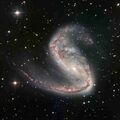Файл:Ngc2442 wide field cropped.jpg

Размер этого предпросмотра: 600 × 600 пкс. Другое разрешение: 1638 × 1638 пкс.
Исходный файл (1638 × 1638 пкс, размер файла: 43 КБ, MIME-тип: image/jpeg)
Описание
| Описание | This picture of the Meathook Galaxy (NGC 2442) was taken by the Wide Field Imager on the MPG/ESO 2.2-metre telescope at La Silla, Chile. It shows a much broader view than the Hubble image, although less detailed. This view includes the whole galaxy and the surrounding sky, and clearly shows the asymmetric spiral arms. The longer of the two arms has intense star formation, which is visible here as a pink glow: this is due to the radiation of young stars ionising the gas they form from. The asymmetric shape and star formation are both thought to be caused by tidal disruptions from a near-miss with another galaxy at some point in its history. |
|---|---|
| Источник | |
| Время создания | 2011-05-09 08:48 |
| Автор или правообладатель |
|
| Другие версии файла | — |
Источник файла — сайт Wikimedia Commons, куда он был загружен под одной из свободных лицензий ( https://commons.wikimedia.org/wiki/File:Ngc2442_wide_field_cropped.jpg ). Авторов, работавших над этим файлом см. в истории файла: https://commons.wikimedia.org/w/index.php?title=File:Ngc2442_wide_field_cropped.jpg&action=history
В общем случае в статьях энциклопедии Руниверсалис файлы используются в соответствии со статьёй 1274 Гражданского кодекса Российской Федерации.
История файла
Нажмите на дату/время, чтобы увидеть версию файла от того времени.
| Дата/время | Миниатюра | Размеры | Участник | Примечание | |
|---|---|---|---|---|---|
| текущий | 17:40, 22 ноября 2023 |  | 1638 × 1638 (43 КБ) | I, Robot (обсуждение | вклад) | == Описание == {{Изображение | описание = This picture of the Meathook Galaxy (NGC 2442) was taken by the Wide Field Imager on the MPG/ESO 2.2-metre telescope at La Silla, Chile. It shows a much broader view than the Hubble image, although less detailed. This view includes the whole galaxy and the surrounding sky, and clearly shows the asymmetric spiral arms. The longer of the two arms has intense star formation, which is visible here as a pink glow: this is due to the radiation of young sta... |
Вы не можете перезаписать этот файл.
Использование файла
Следующая страница использует этот файл: